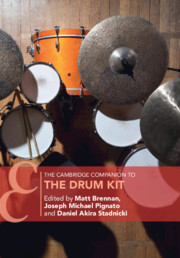Book contents
- The Cambridge Companion to the Drum Kit
- Cambridge Companions to Music
- The Cambridge Companion to the Drum Kit
- Copyright page
- Contents
- Figures
- Tables
- Music Examples
- Notes on Contributors
- Introduction
- Part I Histories of the Drum Kit
- 1 The Drum Kit in Theory
- 2 Historically Informed Jazz Performance on the Drum Kit
- 3 Towards a Cultural History of the Backbeat
- 4 Historicizing a Scene and Sound
- Part II Analysing the Drum Kit in Performance
- Part III Learning, Teaching, and Leading on the Drum Kit
- Part IV Drumming Bodies, Meaning, and Identity
- Index
3 - Towards a Cultural History of the Backbeat
from Part I - Histories of the Drum Kit
Published online by Cambridge University Press: 28 May 2021
- The Cambridge Companion to the Drum Kit
- Cambridge Companions to Music
- The Cambridge Companion to the Drum Kit
- Copyright page
- Contents
- Figures
- Tables
- Music Examples
- Notes on Contributors
- Introduction
- Part I Histories of the Drum Kit
- 1 The Drum Kit in Theory
- 2 Historically Informed Jazz Performance on the Drum Kit
- 3 Towards a Cultural History of the Backbeat
- 4 Historicizing a Scene and Sound
- Part II Analysing the Drum Kit in Performance
- Part III Learning, Teaching, and Leading on the Drum Kit
- Part IV Drumming Bodies, Meaning, and Identity
- Index
Summary
When rock and roll exploded onto the American cultural mainstream in the 1950s, enthusiasts and detractors alike identified the backbeat as the most distinctive and captivating feature of this controversial ‘new’ music. Although it shocked many, the backbeat soon became ubiquitous, and it remains among the most prevalent features in contemporary popular music around the globe. Long before the rock and roll revolution, backbeating had a rich history in the performance of African-American music, dance, worship, labour, and sexuality. This chapter establishes the backbeat as a pervasive and powerful manifestation of signifyin(g), as theorized by Henry Louis Gates, Jr, a strategic form of cultural production that responds to, reinterprets, and builds upon received texts or expressions to expose, challenge, and invert the hierarchies they (re)produce. The origins of the backbeat are traced to nineteenth- and early twentieth-century African-American musical traditions – including worship music, prison songs, early jazz, and hokum blues – and its early history is charted through a critical survey of recordings from the 1920s to the 1950s. This history reveals that the backbeat often functioned as a means of resisting oppressive social structures and forging group solidarity, and it illuminates how and why the backbeat became a central convention of drum kit performance practice.
Keywords
- Type
- Chapter
- Information
- The Cambridge Companion to the Drum Kit , pp. 34 - 51Publisher: Cambridge University PressPrint publication year: 2021



